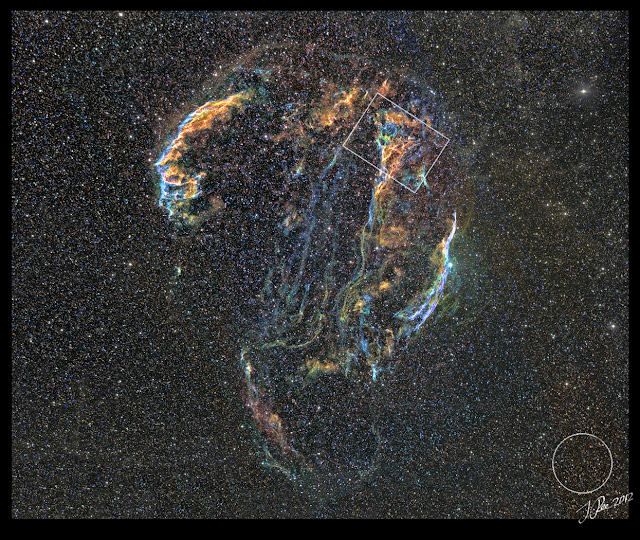COPYRIGHT, PLEASE NOTE
All the material on this website is copyrighted to J-P Metsavainio, if not otherwise stated. Any content on this website may not be reproduced without the author’s permission.
BUY A MUSEUM QUALITY POSTER
BUY A POSTER:https://astroanarchy.zenfolio.com/
Tuesday, November 13, 2012
Pickering's Triangle, project finalized
The Pickering's Triangle
A detail of the Veil Nebula supernova remnant
Image is in mapped colors, from the emission of ionized elements, R=Sulfur, G=Hydrogen and B=Oxygen.
Image is in mapped colors, from the emission of ionized elements, R=Sulfur, G=Hydrogen and B=Oxygen.
This combination is generally called to HST-palette. It's used originally by the Hubble Space Telescope.
I managed to shoot enough data for the S-II channel, to build a three channel color image, last night.
It was very windy and i had hard time with guiding. There was some serious technical difficulties with my gears. After spending ten busy hours up in the observatory, I had only four 20 min. S-II frames, duh...
Pickering's Triangle, Simeis 3-188, is a small part of the Veil Nebula supernova remnant in constellation Cygnus.
Veil Nebula is a cloud of ionized gas and dust, leftovers from an exploded star. The star went off some 5000-8000 years ago at distance of about 1470 light years. This, relatively faint target, is difficult to image due to the large angular diameter, about three degrees, and a dense star field.
Orientation

Area of interest is marked as a white rectangle, the apparent size of the Moon can be seen at lower right corner.
Image in natural colors
R=Hydrogen + Sulfur, G=Oxygen and B=Oxygen + Hydrogen.
Technical details:
Processing work flow:
Image acquisition, MaxiDL v5.07.
Stacked and calibrated in CCDStack2.
Levels, curves and color combine in PS CS3.
Optics, Meade LX200 GPS 12" @ f5
Camera, QHY9
Guiding, SXV-AO, an active optics unit, and Lodestar guide camera 8Hz
Image Scale, ~0,8 arc-seconds/pixel
15 x 1200s exposures for the H-alpha, emission of ionized Hydrogen = 5h
9 x 1200s exposures for the O-III, emission of ionized Oxygen = 3h
4x1200s exposures for the S-II, emission of ionized Sulfur = 1h 20min.
Ps.
An animation, stars vs. starless
Sometimes I'm publishing starless versions of my images. The actual nebula stands out better by this way, since human brains has a habit to form false shapes from a group of random dots, like stars.
Subscribe to:
Post Comments (Atom)













No comments:
Post a Comment